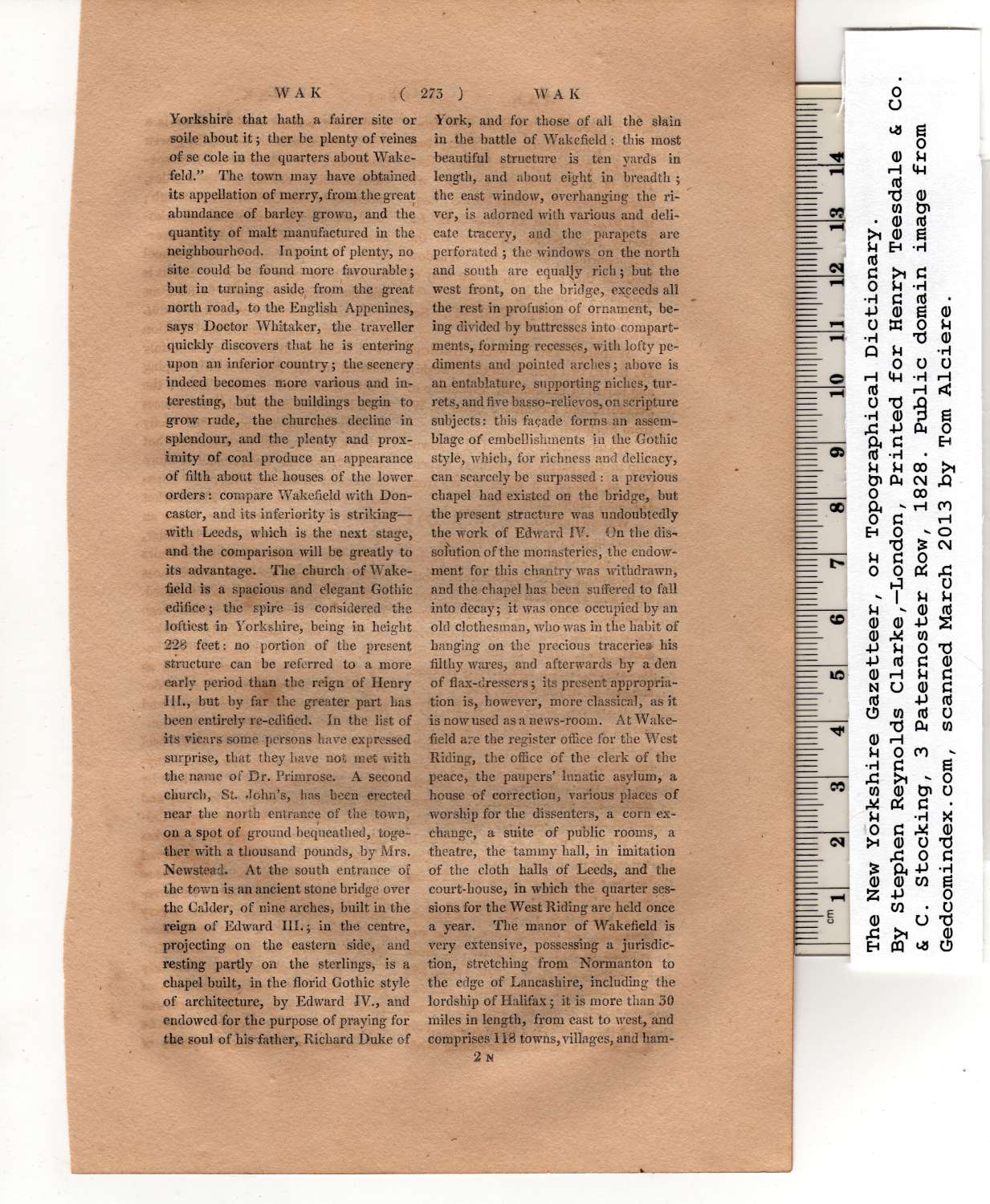|
Yorkshire that hath a fairer site or
soile about it; ther be plenty of veines
of se cole in the quarters about Wake-
feld.” The town may have obtained
its appellation of merry, from the great
abundance of barley grown, and the
quantity of malt manufactured in the
neighbourhood. In point of plenty, no
site could be found more favourable;
but in turning aside from the great
north road, to the English Appenines,
says Doctor Whitaker, the traveller
quickly discovers that he is entering
upon an inferior country; the scenery
indeed becomes more various ancl in-
teresting, but the buildings begin to
grow rude, the churches decline in
splendour, and the plenty and prox-
imity of coal produce an appearance
of filth about the houses of the lower
orders: compare Wakefield with Don-
caster, and its inferiority is striking—
with Leeds, which is the next stage,
and the comparison will be greatly to
its advantage. The church of Wake-
field is a spacious and elegant Gothic
edifice; the spire is considered the
loftiest in Yorkshire, being in height
228 feet: no portion of the present
structure can be referred to a more
early period than the reign of Henry
III., but by far the greater part has
been entirely re-edified. In the list of
its vicars some persons have expressed
surprise, that they have not met with
the name of Dr. Primrose. A second
church, St. John’s, has been erected
near the north entrance of the town,
on a spot of ground bequeathed, toge-
ther with a thousand pounds, by Mrs.
Newstead. At the south entrance of
the town is an ancient stone bridge over
the Calder, of nine arches, built in the
reign of Edward III.; in the centre,
projecting on the eastern side, and
resting partly on the sterlings, is a
chapel built, in the florid Gothic style
of architecture, by Edward IV., and
endowed for the purpose of praying for
the soul of hisYather, Richard Duke of |
York, and for those of all the slain
in the battle of Wakefield: this most
beautiful structure is ten yards in
length, and about eight in breadth ;
the east window, overhanging the ri-
ver, is adorned with various and deli-
cate tracery, and the parapets are
perforated ; the windows on the north
and south are equally rich; but the
west front, on the bridge, exceeds all
the rest in profusion of ornament, be-
ing divided by buttresses into compart-
ments, forming recesses, with lofty pe-
diments and pointed arches; above is
an entablature, supporting niches, tur-
rets, and five basso-relievos, on scripture
subjects: this facade forms an assem-
blage of embellishments in the Gothic
style, which, for richness and delicacy,
can scarcely be surpassed: a previous
cbapel had existed on the bridge, but
the present structure was undoubtedly
the work of Edward IV. On the dis-
solution of the monasteries, the endow-
ment for this chantry was withdrawn,
and the chapel has been suffered to fall
into decay; it was once occupied by an
old clcthesman, who was in the habit of
hanging on the precious traceries his
filthy wares, and afterwards by a den
of flax-dressers; its present appropria-
tion is, however, more classical, as \t
is now used as a news-room. At Wake-
field are the register office for the West
Riding, the office of the clerk of the
peace, the paupers’ lunatic asylum, a
house of correction, various places of
worship for the dissenters, a corn ex-
change, a suite of public rooms, a
theatre, the tammy hall, in imitation
of the doth halls of Leeds, and the
court-house, in which the quarter ses-
sions for the West Riding are held once
a year. The manor of Wakefield is
very extensive, possessing a jurisdic-
tion, stretching from Normanton to
the edge of Lancashire, including the
lordship of Halifax; it is more than 30
miles in length, from east to west, and
comprises 118 towns, villages, and ham*
2k |
